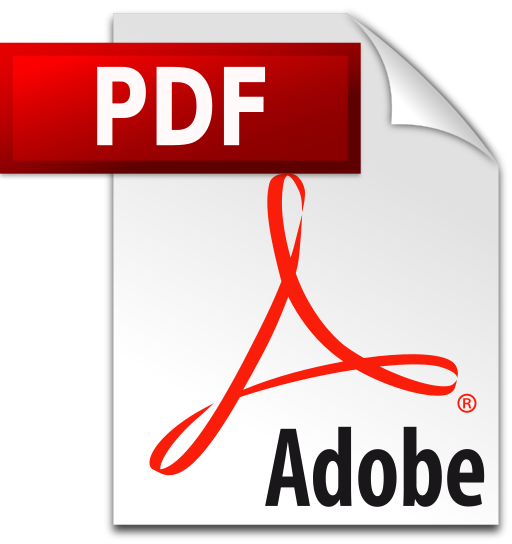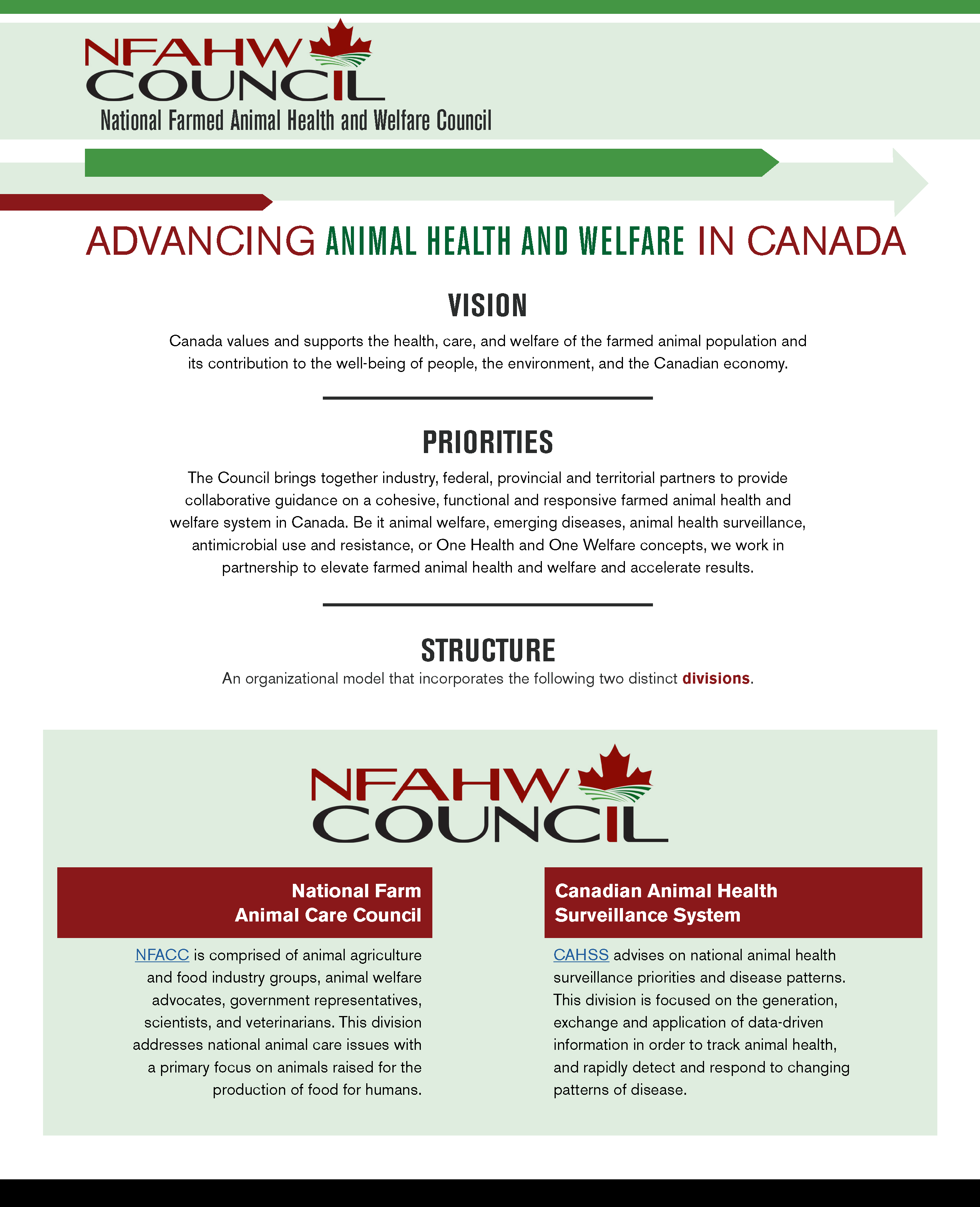NFACC Information Update May 2020
- NFACC officially becomes a division of the National Farmed Animal Health and Welfare (NFAHW) Council
- NFACC welcomes new Associate Members
- Update on Codes of Practice under revision/development
- Amendment to the Farmed Mink Code of Practice
- NFACC in the news
- Upcoming events
NFACC OFFICIALLY BECOMES A DIVISION OF THE NATIONAL FARMED ANIMAL HEALTH AND WELFARE (NFAHW) COUNCIL
On April 1, 2020 NFACC officially became a division of the NFAHW Council. The NFAHW Council and NFACC worked together over many months to develop terms of reference and a governance process, along with financial and budgetary planning and reporting tools. This is an exciting opportunity to enhance animal welfare collaboration and synergies between the two organizations.
NFACC’s mandate will not change. NFACC will continue to bring together diverse stakeholders to:
- develop Codes of Practice for the care and handling of farm animals,
- create a process for the development of animal care assessment programs,
- provide a forum for open dialogue on farm animal welfare
NFACC WELCOMES NEW ASSOCIATE MEMBER
NFACC is pleased to welcome new associate member:
"Lactalis Canada is a leader in dairy processing with iconic brands like Beatrice, Lactantia, Astro, Black Diamond, Cheestrings, Balderson, Cracker Barrel, P'tit Québec, aMOOza!, siggi's and more. For us, it is of paramount importance that milk-producing cows are treated according to rigorous standards. By becoming a member of NFACC we are joining a strong partnership and will have even more opportunities to support the development and adoption of scientifically-informed practices to continuously improve animal health and welfare." - Olivier Charbonneau, Director, Government, Regulatory & Industry Affairs
UPDATE ON CODES OF PRACTICE UNDER REVISION/DEVELOPMENT
Along with NFACC’s operations, NFACC’s Codes Project (CAP-AAPN-001 – Advancing Animal Welfare and Public Trust Through Codes of Practice) will transition to the NFAHW Council (from the Canadian Animal Health Coalition). While the project’s transition has been delayed due to the impacts of COVID 19, activity is still underway to move the project over in the near future.
All manner of activities have been impacted by COVID 19 and the Codes project is no different. In person meetings have been postponed, cancelled, or re-worked as virtual alternatives are explored. The project team is fluent in “working from home” and it has been truly impressive to see the ongoing commitment of all stakeholders in spite of the challenges that the pandemic is creating for individuals and businesses. Thank you to all who are engaged on this project and for remaining committed to farm animal welfare in Canada.
Work on the dairy cattle, farmed salmonid, goat, and transportation Codes of Practice continues with progress updates provided below. Given the pandemic we are currently re-assessing timelines for each Code. Public Comment Periods may be delayed in some cases by a few months. We will update as timeline projections are firmed up.
Dairy Cattle Code
The late March meeting of the Code Development Committee was adapted to a remote/online format consisting of 3 sessions each focused on a chapter of the Scientific Committee’s report on priority welfare issues. Chapters reviewed were lameness and injuries, end of life management, and exercise and outdoor access.
Trevor DeVries and Elsa Vasseur, as co-Chairs of the Scientific Committee, presented an overview of the research on each of these topics, and this was followed by a Q and A. While most questions related to the research summarized, committee members also posed questions to other committee members, and, in this way, the group was able to draw out the various types of expertise around the “virtual table”. The last portion of each session consisted of a roundtable with committee members offering preliminary thoughts on the topics presented and possible ways to address them in the updated Code. While this made for a great exchange of insights, it is very much the first of many discussions to be had while committee members continue to digest all the research on these complex topics to be addressed in the updated Code of Practice.
The next meeting has been scheduled for June (also remote/online). In the meantime, the Scientific Committee’s report will be peer reviewed and sub-sets of the Code Committee will continue to draft selected sections of the Code for later review by the entire Code Committee.
Additional details and a high-level overview of the research summarized are available here.
Farmed Salmonid Code
In their March meeting, the Code Development Committee developed content on hatcheries and nurseries – a critically important production stage necessitating attentive, skilled husbandry. Content was drafted on egg management, first feeding, lighting, and optimizing pre- and post-transfer conditions for grow out. Beyond this, the Code Committee worked through a draft Code chapter on euthanasia, slaughter, and mass depopulation (e.g. acceptable methods, training and protocols, and criteria for euthanasia).
With the remaining chapters of the Scientific Committee’s report on priority welfare issues now drafted and presented to the Code Committee (at the March meeting and via webinar in April), the report will now be submitted for peer review.
A full summary of this meeting is available here.
Goat Code
Owing to Covid-19 travel restrictions, face-to-face meeting # 4 –– that had been arranged for April 2020 in Saskatoon, Saskatchewan – was initially postponed and then subsequently cancelled. In turn, members of the respective Code sub-committees have continued to correspond among themselves in preparation for the resumption of more collective interactions involving the entire Code committee (i.e., using virtual meeting formats). To this end, for example, arrangements have now been completed for the commissioning of professional illustrations that will be included in the Code to provide accompanying visual support related to textual descriptions, requirements, and recommended practices.
Important advances have also been made with regard to the work of the Code Scientific Committee. The draft version of the Scientific Report is now complete. It has also been forwarded for scientific peer review. Over the course of approximately four to six weeks, a number of highly qualified animal science specialists will rigorously review the document for clarity, scholarship, and scope. Once returned, any or all recommended edits will be addressed by the Scientific Committee and the research writer. Upon completion, the report will be carefully reviewed by all members of the Code committee and will be used to provide guidance on priority welfare issues.
Transportation Code
Like other Codes in development, work on the Livestock and Poultry Transportation Code of Practice is continuing, albeit under conditions that were completely unexpected as recently as a few months ago. Social distancing protocols resulting from the COVID-19 pandemic have halted the ability for in-person meetings for the foreseeable future. Ironically, this comes on the heels of recent acknowledgement of the importance of bringing groups together for the first time in a face-to-face environment.
Fortunately, the Sheep/Goat Working Group (WG) was able to squeeze in its first meeting at the end of February in Ottawa, when what appeared to be the biggest concern was the winter weather that ended the meeting early and foiled many travel plans. The Poultry Catching and Transportation WG met over the same two days, and both WGs were able to use the opportunity to select their representatives to the Code Development Committee (CDC).
With those two picks, all eight species-specific WGs are now represented on the CDC, which has now been fully populated. The 23-member CDC also includes livestock and poultry transporters; researchers; processors; and individuals representing animal welfare advocacy and enforcement, livestock markets, veterinarians and the federal government.
Normally, the next step would be to convene the CDC’s inaugural in-person meeting over two days. As that is no longer an option, the Transport Code Management team is currently organizing a series of online meetings that when combined together, will take the place of the in-person meeting. While this is not ideal, the team is also working on developing strategies to facilitate sessions that are productive, inclusive, efficient, and effective. The first CDC “meeting” is scheduled to take place in June.
Two WGs are also in the position of having to migrate to online meeting platforms for their first meetings. The Equine WG had tentatively scheduled its first meeting for May in Calgary; however, with travel on-hold, efforts will soon be underway to reschedule to an online format. The Intermediary Sites WG is nearly fully populated. Once complete, online meetings will be scheduled for summer. This WG will draft content that covers the care of animals at three primary types of sites at which animals are temporarily unloaded, and that are considered to be part of the animal transportation continuum: sales/auction yards; assembly yards; and feed/water/rest stations.
In the meantime, the Poultry Catching and Transport WG, the Hatchery Transport WG, and the Bison/Cervid WG continue to hold online meetings, while the remaining species-specific WGs (Cattle; Pigs; Sheep/Goats; Mink/Fox/Rabbit) have temporarily halted work while they wait for the CDC to draft common content, after which they will reconvene to tease out animal-specific content where deemed appropriate.
Amendment to the Farmed Mink Code of Practice
The mink Code of Practice was released in 2013 and underwent its 5-year review in 2018. The Code Technical Panel recommended that an amendment be undertaken. Code amendments should be developed when:
- A conflict with another Code has been identified,
- Obstacles to trade and markets have been identified,
- Requirements are deemed to be impracticable,
- Updates are necessary to be in respect of current practices, scientific advances, market requirements or legislation.
The Canada Mink Breeders Association is leading the amendment following NFACC’s amendment process. Details on the Code amendment’s scope and project timelines are available here.
For information on the steps of the Code development process and progress of the Codes being updated follow this link.
Funding for this project has been provided through the AgriAssurance Program under the Canadian Agricultural Partnership, a federal–provincial–territorial initiative.



